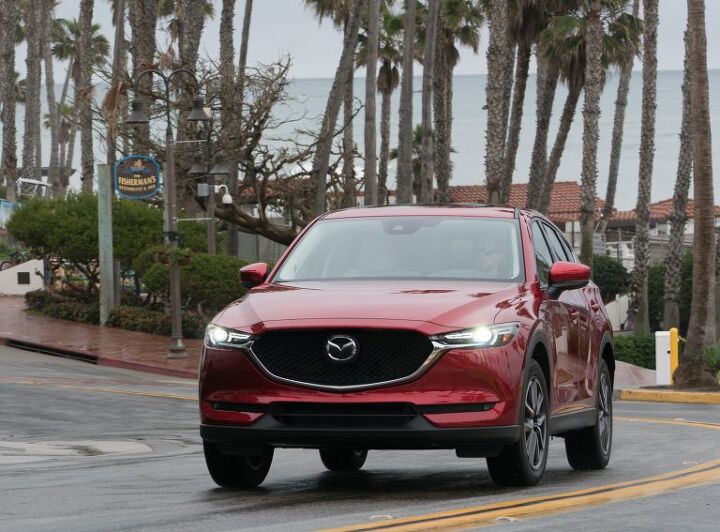Mazda and Toyota's Joint Venture Is Official, Tons of Corollas and a Mystery Model Await

There’s 4,000 new jobs coming to Huntsville, Alabama, but there’ll also be 150,000 unnamed Mazda crossovers rolling out to dealers across North America each year — assuming the model’s a success. Our money’s on Mazda giving its new child a name starting with “CX-.”
Mazda and Toyota made their 50-50 joint venture official this week, creating a business entity called Mazda Toyota Manufacturing, U.S.A., Inc. and boosting the presence of car manufacturing in the South. Production begins in 2021. For Mazda, it will be the company’s first assembly facility in the U.S., though it’s technically not a wholly-owned, standalone operation. There’ll be just as many Toyota Corollas leaving the factory as Mazdas.
While there are scant clues about the nature of Mazda’s mystery vehicle, the brand’s recent sales, plus a revealing loyalty report, suggest the company could have a hit on its hands.
“We hope to make MTMUS a plant that will hold a special place in the heart of the local community for many, many years,” said Mazda’s Executive Officer Masashi Aihara, who also holds the position of president of the venture.
To the best of anyone’s knowledge, the CX-3, CX-5, and CX-9 will remain in their respective places in Mazda’s lineup. The new model, almost certainly slotted towards the higher end of the lineup, is designed to appeal specifically to U.S. buyers, the company claims. Nor will it step on any models’ toes and cannibalize sales. This seems like a tall order, but Mazda isn’t known for its lazy, rushed judgement.
The company plans to devote its entire annual production capacity of 150,000 vehicles to this new crossover — a number higher than the sales of any existing Mazda model in the United States. Talk about high hopes. Even the brand’s top-selling model, the CX-5, didn’t reach that number in the U.S. last year (its best sales year to date), though it passes the 150k barrier if you add in Canadian sales. No other model comes close.
Actually, the CX-5 deserves further mention. After rising every year since its 2012 introduction, sales of the CX-5 seem to have exploded as of late. U.S. sales rose 13.7 percent in 2017 compared to the previous year. Over the first two months of 2018, sales are up 67.8 percent — enough to give the automaker its best February showing in the U.S. in 24 years. This, despite double-digit decreases in Mazda 3, 6, and MX-5 volume.
If the 2021 CX-? is able to garner this kind of demand, it won’t matter what buyers think of Mazda’s passenger cars, or even whether they exist.
Another item of note: Last week, Edmunds published its annual customer loyalty report, which delves into the likelihood of buyers trading in their vehicle for one of the same brand. In it was plenty of good news for Mazda.
For starters, SUV owners are most likely (75 percent) to stick with the same bodystyle at trade-in time. Loyalty among brands was also higher for Japanese automakers (83 percent). For Mazda, loyalty rates rose from 23 percent to 44 percent between 2007 and 2017 — the largest improvement of any mainstream automaker.
All of this sets up Mazda’s mystery vehicle for success, but there was another key finding in Edmunds’ report. It’s a doozy.
Mazda “has the distinction of having the vehicle with the highest number of return customers of any single vehicle in 2017 with its CX-5,” Edmunds discovered.
Will Mazda’s mystery vehicle be something passionately loyal CX-5 owners can move up to? A three-row with greater affordability than the CX-9, perhaps?
[Image: Mazda]

More by Steph Willems
Latest Car Reviews
Read moreLatest Product Reviews
Read moreRecent Comments
- Lou_BC Nah. Tis but a scratch. It's not as if they canceled a pickup model or SUV. Does anyone really care about one less Chevy car?
- ToolGuy If by "sedan" we mean a long (enough) wheelbase, roomy first and second row, the right H point, prodigious torqueages, the correct balance of ride/handling for long-distance touring, large useable trunk, lush enveloping sound system, excellent seat comfort, thoughtful interior storage etc. etc. then yes we need 'more' sedans, not a lot more, just a few really nice ones.If by "sedan" we mean the twisted interpretation by the youts from ArtCenter who apparently want to sit on the pavement in a cramped F16 cockpit and punish any rear seat occupants, then no, we don't need that, very few people want that (outside of the 3 people who 'designed' it) which is why they didn't sell and got canceled.Refer to 2019 Avalon for a case study in how to kill a sedan by listening to the 'stylists' and prioritizing the wrong things.
- Lou_BC Just build 4 sizes of pickups. Anyone who doesn't want one can buy a pickup based SUV ;)
- Jor65756038 If GM doesn't sell a sedan, I'll buy elswhere. Not everybody likes SUV's or crossovers or is willing to buy one no matter what.
- ToolGuy One thing is for sure: Automakers have never gone wrong following the half-baked product planning advice of automotive journalists. LOL.I wonder: Does the executive team at GM get their financial information from the Manager of Product and Consumer Insights at AutoPacific? Or do they have another source? Hmm...


































Comments
Join the conversation
I'm hoping for a SkyactivX plug in hybrid...
My guess is a shortened 2 row cx9.Basically the opposite of what Lexus did with the RX.Mazda has been able to jump out of the edge and murano segment and now compete with Lexus Acura Volvo Infinity.In fact 2 people I know ended up in Cx9 after starting out for MDX and RXs.